Let us take . a look in the rear view mirror and see the technology used in the first Volvo S80 introduced back in 1998. What has happened in society the last 10 to 15 years that has influenced the development of the vehicle’s electrical system? How has Volvo Cars adapted to the new demands from customers and society?
The C30 Electric, the all-new V60 hybrid, new safety and vehicle infotainment functions that require modern faster wired and wireless communication technologies and more computer performance.
Development of new technologies will have consequences for EMC. Test methods and requirements better suited to modern technologies should be developed.
What was the status 10-15 years ago?
The first Volvo S80 was introduced in 1998. In this new platform the complexity of the electrical system increased dramatically compared to earlier platforms. Software realizing the functions was distributed over several nodes in a network.
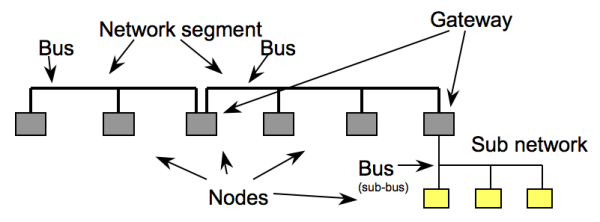
There were three network types used for data transmission between the nodes:
- CAN – Controller Area Network, 125 – 250 kbit/s.
- LIN – Local Interconnect Network, 9,6 kbit/s.
- MOST – Media Oriented Systems Transport, 25 Mbit/s.
GSM/GPRS and GPS were technologies that had started to be integrated in the vehicle system to realize optional functionalities.
What has happened in society since then?
Since 1998, when the first Volvo S80 was introduced, society has developed greatly in technology. Recently, three main areas have influenced Volvo Cars:
- The discussion of Global warming.
- Intensified focus on traffic safety. Traffic accidents is still a big issue globally.
- People being constantly connected.
1. Global Warming
There has been an intensive political debate on global warming. Strong political efforts are made to reduce CO2 emissions from the combustion of fossil fuels.
In the automotive industry focus has gone from CO, NOx and HC reduction to the reduction of CO2. Interest has increased for non-fossil fuels like ethanol and bio-gas. Vehicles with hybrid or full-electrical drive lines are developed by most all car manufacturers. Technologies like regenerative braking, start-stop functionality and smart power management are used more and more in modern vehicles.
2. Traffic Safety
EU has formulated a goal to reach close to zero fatal traffic accidents by 2050 and halve the number of fatalities between 2010 and 2020. Volvo Cars strive to be leading in this area. In this area many new functions will be developed in the coming years. Several of them will be based on wireless communication.
3. Constantly Connected
In the area of being ‘Constantly Connected’ a lot has happened in the last 10-15 years. Children do not play outside after school today. They are playing computer games and communicate with their friends via the internet. More and more of social networking and entertainment are accessed via broadband internet connection from our homes. The number of smartphones and tablets has increased dramatically during the past few years. We have access to all these services in our homes (film, music, games, information), and we also require such access in our vehicles!
How has Volvo adapted to the new demands from customers and society?
Global warming:
Volvo Cars offers vehicles using alternative fuels. Examples are the C30 Electric and the V60 Hybrid.
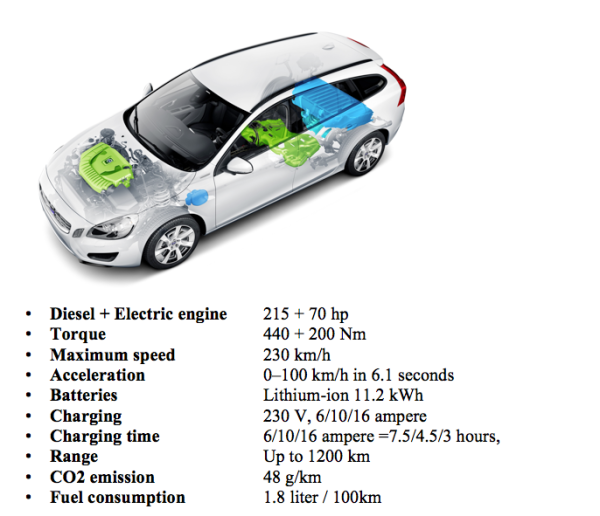
Traffic safety:
In today’s models Volvo Cars offers a wide range of safety functions aiming to reduce the number of accidents or the risk of getting injured.
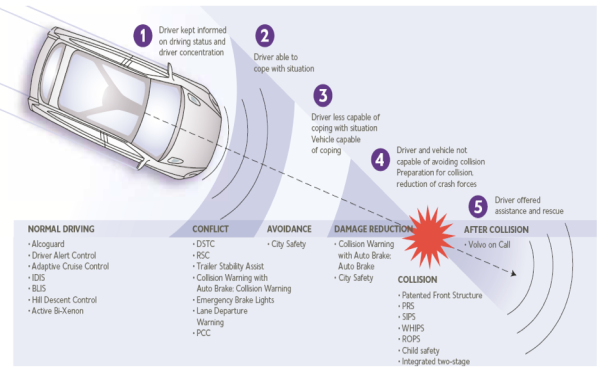
Since 1998 Volvo Cars has offered Volvo on Call, a GSM and GPS technology based system which automatically, in case of emergency, sends an alarm to the Volvo on Call Center. The system can also be used if assistance is needed for other reasons.
Constantly Connected:
A Volvo is today a complex product in which several radio based services are used to transmit all the data needed for the vehicle functions or infotainment.
Since early 2013 Volvo customers can buy Sensus Connected Touch as an option. This system allows you to connect to the internet in the vehicle. Services as web browsing, streaming music, internet radio and on line navigation can be used.
What are the technologies coming and what are the EMC consequences?
The complexity of a vehicle will increase even further in the coming years. The table below gives an indication of the complexity of a ”near production” vehicle.
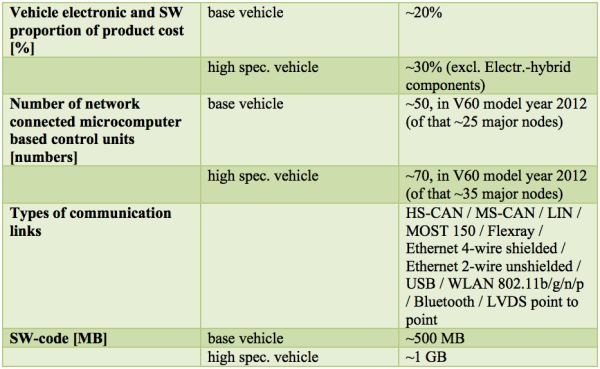
In a production high spec. vehicle ~700 functions are distributed over ~70 Electronic Control Units (ECU).
The number of radio based systems increases and 35-40 antennas for different systems are packed together with ~70 ECUs with less than 5m separation.
Radio frequencies between 125 kHz and 77 GHz are used in the vehicle.
Data rate up to several Gbit/s is new to the automotive industry. The strong focus on cost and the tough automotive environmental requirements will force the suppliers to challenge traditional methods to realize high speed digital electronics.
In the electric driveline, switched power electronics using switch frequencies at 20 kHz and peak currents up to 150 A, have shown to give significant emissions up to 200-250 MHz. Altogether this will give the automotive EMC engineers an interesting challenge in the coming years. Especially to secure good radio reception performance at all frequency bands used for communication and broadcasting reception in the vehicle.
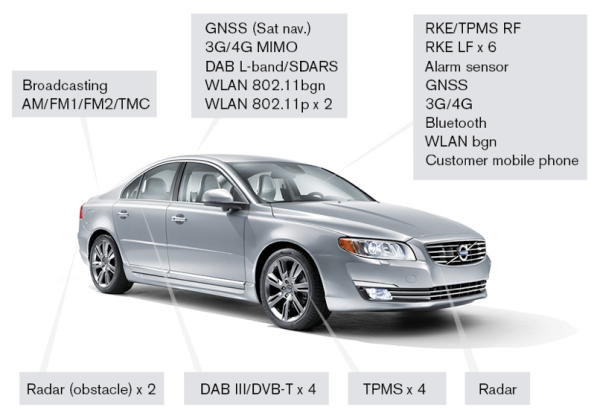
One of the more significant roadblocks for smooth EMC-work in the vehicle projects is that present EMC standards were originally developed to protect analogue receivers (broadcast radio receivers) from electromagnetic disturbances. The disturbances at the time of the original version of the standards were mainly limited to the ignition systems in the vehicles. A modern vehicle is connected to a large number of communication channels and a majority of them are digital. Application examples are receivers for broadcast signals (e.g. DAB, DVB-T, RDS) and nodes for car-to-x communication (e.g. TETRA, 2G, 3G, 4G, Wi-Fi), some of them constituting sensors for active safety systems. There is also an incredible growth of interference sources, as well as completely new types of disturbances to take into consideration.
An approach to improve EMC for wireless communication in the vehicles
Volvo Cars and AB Volvo together with SP (Sveriges Tekniska Forskningsinstitut AB), FOI (Totalförsvarets Forskningsinstitut) and Provinn AB have, with financial support from VINNOVA, started a project aiming at developing new EMC test methods and simulation models to be used to improve the performance (both reliability and capacity) of wireless digital communication services. This will ensure high availability of implemented safety and transport efficiency functions.
The name of the project is “EMC for wireless Communication systems in Vehicles – EMCCOM”
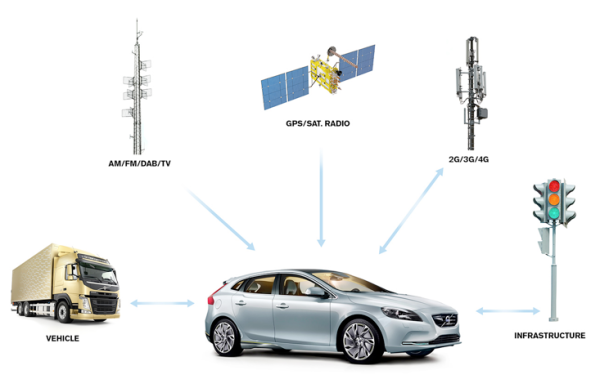
The approach of this project is to gain knowledge about existing and future digital communication systems. System parameters such as package rates, modulation schemes etc. vary between the systems, and makes them susceptible to different types of disturbances.
The disturbances will be studied in detail. When performing standard EMC testing, the test methods are basically limited to measuring the amplitude in the frequency domain. This is not sufficient for deeper studies. Time-domain and statistical methods to characterize the disturbances will be used in EMCCOM in order to estimate their impact on different kinds of radio systems.
Standard EMC testing is performed in a standardized environment (on a copper plane) and many times with a quasi-peak detector (originally developed to measure the severity of disturbances on AM signals), but recently also with average detectors (more suited to evaluate the severity on digital signals). We intend to develop new methods to test ECUs. The methods will be more suitable for the characterization necessary for modelling digital communication systems.
Digital systems of high importance for automotive applications that will be considered when prioritizing the work in the project include 3G, LTE, WiFi (IEEE 802.11b, g, n), IEEE 802.11p, and GPS.
A vital part is the development of low-complexity models of prioritized communication systems. The models will be designed to catch relevant vulnerability behaviour of the different wireless systems.
EMCCOM has a total budget of 7.3 MSEK and ends in the middle of 2015.
Björn Bergqvist, Volvo Cars Torbjörn Persson, Provinn AB
List of abbreviation
- DSTC – Dynamic Stability and Traction Control
- RSC – Roll Stability Control
- IDIS – Intelligent Driver Information System
- BLIS – Blind Spot Indication System
- PCC – Personal Car Communicator
- PRS – Pre-prepared Restraints System
- SIPS – Side Impact Protection System
- WHIPS – Whiplash Protection System
- ROPS – Roll Over Protection System
- TMC – Traffic Message Channel
- GNSS – Global Navigation Satellite System
- MIMO – Multiple Input Multiple Output
- DAB – Digital Audio Broadcasting
- SDARS – Satellite Digital Audio Radio Service
- WLAN – Wireless Local Area Network
- RKE – Remote Keyless Entry
- TPMS – Tire Pressure Monitoring System
- DVB-T – Digital Video Broadcasting-Terrestrial
- RDS – Radio Data System
- TETRA – TErrestrial Trunked Radio- Mobile digital radio for professional use (military, public safety, …)

